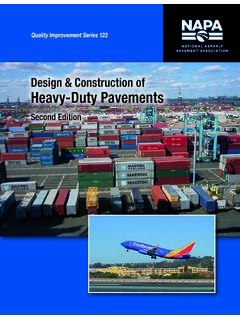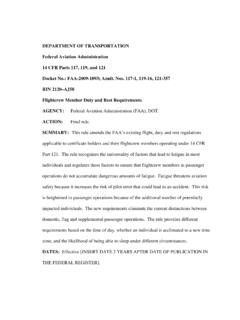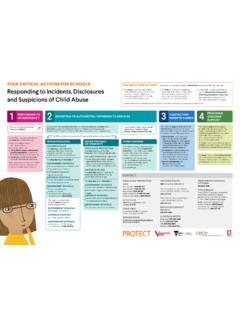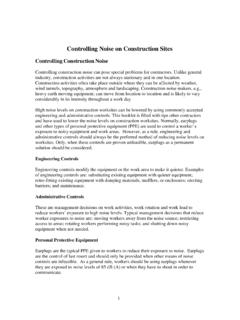Transcription of protect duty consultation - GOV.UK
1 protect duty consultation Making the public safer at publicly accessible locations 2 Contents Contents 2 About this consultation 3 Ministerial foreword 5 Introduction 7 An introduction to protective security for owners and operators of publicly accessible locations 9 Section 1: Who (or where) should legislation apply to? 12 Section 2: What should the requirements be? 17 Section 3: How should compliance work? 26 Section 4: How should government best support and work with partners? 29 Responding to this consultation 34 Glossary 36 Table 1: Glossary of terms used in the protect duty consultation . 36 Annex 1 - Exemptions and exclusions 38 Annex 2 Best practice examples of security considerations and mitigations at different organisations 39 Annex 3 - What types of cost and benefits are expected? 48 Annex 4 List of consultation questions 50 3 About this consultation To This consultation is open to the public, and is targeted at venues, organisations, businesses, local and public authorities, and/or individuals who own or operate at publicly accessible locations or others that a protect duty would potentially affect.
2 A publicly accessible location is defined as any place to which the public or any section of the public has access, on payment or otherwise, as of right or by virtue of express or implied permission. Publicly accessible locations include a wide variety of everyday locations such as: sports stadiums; festivals and music venues; hotels; pubs; clubs; bars and casinos; high streets; retail stores; shopping centres and markets; schools and universities; medical centres and hospitals; places of worship; Government offices; job centres; transport hubs; parks; beaches; public squares and other open spaces. This list is by no means exhaustive, but it does demonstrate the diverse nature of publicly accessible locations. We welcome responses from anyone with an interest in or experience of the areas being consulted on within this consultation . The consultation relates to the United Kingdom of Great Britain and Northern Ireland only.
3 Duration: From 26 February 2021 to 2 July 2021 Enquiries (including requests for the paper in an alternative format) to: Email: Or protect duty consultation protect and Prepare 5th Floor NE, Peel Building, Office for Security and Counter Terrorism Home Office 2 Marsham Street, London, SW1P 4DF How to respond: There are four thematic sections in this consultation . Respondents can answer as many or as few questions as they wish. You do not have to comment on every section or respond to every question on each section but can focus on where you have relevant views and evidence to share. If you wish to respond to all questions, you do not have to complete the whole form at once. 4 Please send your response by 2 July 2021 Please respond to the questions in this consultation online at: Alternatively, you can send in electronic copies to: or, Alternatively, you may send paper copies to: protect duty consultation protect and Prepare 5th Floor NE, Peel Building, Office for Security and Counter Terrorism Home Office 2 Marsham Street, London, SW1P 4DF Additional ways to respond: If you wish to submit other evidence, or a long-form response, please do so by sending it to the email address or postal address above.
4 Response paper: A response to this consultation and a Regulatory Impact Assessment will be published online at: 5 Ministerial foreword The first duty of the Government is to protect the public. The terrorist threat we currently face is multifaceted, diverse and continually evolving. The police, security services, and other partners do all they can to combat this threat: since March 2017 UK police and security services have foiled 27 plots, including eight motivated by Right Wing ideologies. However, despite their best endeavours, it will never be possible to stop every attack. The attacks we have seen in the UK, particularly since 2017, have caused deaths and casualties amongst people going about their everyday business, often in open, public places; and have changed the lives of many people. The Government is committed to improving the safety and security of public venues, as outlined in its 2019 manifesto.
5 This consultation considers how we can work together to develop proportionate security measures to improve public security. It also considers how those responsible for publicly accessible locations are ready and prepared to take appropriate action, were a terrorist attack to happen. Importantly, we also hope that these proposals respect and acknowledge the important work of all those who have campaigned for legislation. In particular, I want to thank Figen Murray, whose son Martyn was killed in the Manchester Arena attack, for the significant contribution she has made through her tireless campaign to introduce Martyn s Law . We look forward to working with them throughout the consultation period to help gather their views and encourage others to contribute too. There is much good work already being done by many organisations, and I welcome these ongoing efforts. However, in the absence of a legislative requirement, there is no certainty that considerations of security are undertaken by those operating the wide variety of sites and places open to the public, or, where they are undertaken, what outcomes are achieved.
6 This consultation considers how we could improve this position, through reasonable and not overly burdensome security measures. The Government is extremely conscious of the severe impacts that COVID-19 has had, and continues to have, on many businesses and organisations. The thresholds for venues and organisations potentially in scope have been carefully chosen at this time to recognise this. It is envisaged that for many organisations and venues, the requirements of a protect duty would entail minimal new costs. Many have already undertaken or are pursuing ongoing significant work to consider security measures, systems and processes, including through recent consideration of COVID-19 health measures and ensuring appropriate security requirements as part of these. The proposed protect duty is only one part of the Government s approach to improving protective security and preparedness at publicly accessible locations.
7 We continue to seek to engage and provide advice and guidance to all who operate at or have an interest in public security. We also continue to expand and enhance these resources, and, where possible, tailor them to the needs of different user groups. I would encourage all readers of this consultation to consider the simple advice and to access the further reference sources provided at pages 9-11, in the section entitled An introduction to protective security for 6 owners and operators of publicly accessible locations . We remain committed to working with you to protect the public and save lives. RT HON JAMES BROKENSHIRE MP SECURITY MINISTER 7 Introduction This consultation considers how we might use legislation to enhance the protection of publicly accessible locations across the UK from terrorist attacks and ensure organisational preparedness. With some exceptions ( on transport security and for certain sports grounds), there is no legislative requirement to consider or implement security measures at publicly accessible locations.
8 However, there are many reasonable and appropriate measures which can be - and often already are - undertaken by organisations who operate at such locations. These include: Having security plans and procedures to react and respond to different threats which are understood by all staff and regularly exercised; Having simple and freely available training and awareness courses in place as part of new staff and refresher training programmes; and Employing simple security measures (such as door locks, roller shutters) for crime prevention and anti-social behaviour, which may also be used in response to other security threats. For many stakeholders potentially in scope, these are requirements they have already undertaken, or requiring low or nil new costs to take forward. We know that there is a willingness to do more from many businesses and others with public facing operations, and that many organisations operating at publicly accessible locations would welcome a mandatory requirement to consider and mitigate against threats to security.
9 We understand that there is often a low awareness of existing information and tools available, but when organisations have engaged, there is evidence that they go on to implement changes. The next section, An introduction to protective security for owners and operators of publicly accessible locations provides some simple security advice and further reference sources that all can follow. We are mindful of the impact a legislative change could have for some organisations. However, this must be carefully balanced against the need to ensure effective consideration of public security, and the implementation of reasonable security measures, in order to improve public security. We recognise that effective security requires a partnership approach, with Government, police, the security services, the wider public sector, businesses, and the public all having a role to play. If a legislative protect duty were to be introduced, we recognise the need to enhance Government support for all organisations within its scope.
10 This consultation seeks views from all parties that a protect duty would potentially affect - in particular, organisations who own locations or operate at publicly accessible locations. We seek views from across the United Kingdom, since national security is a reserved matter, however we recognise that developing an effective process and support to implement such legislation would draw on delivery mechanisms and responsibilities within the Devolved Administrations. 8 The responses to the consultation questions and additional research and analysis will be used to develop a Regulatory Impact Assessment which will be published in due course. The proposals and discussion issues are broken down into the following sections: Section 1: Who (or where) should legislation apply to? Section 2: What should the requirements be? Section 3: How should compliance work? Section 4: How should Government best support and work with partners?

















